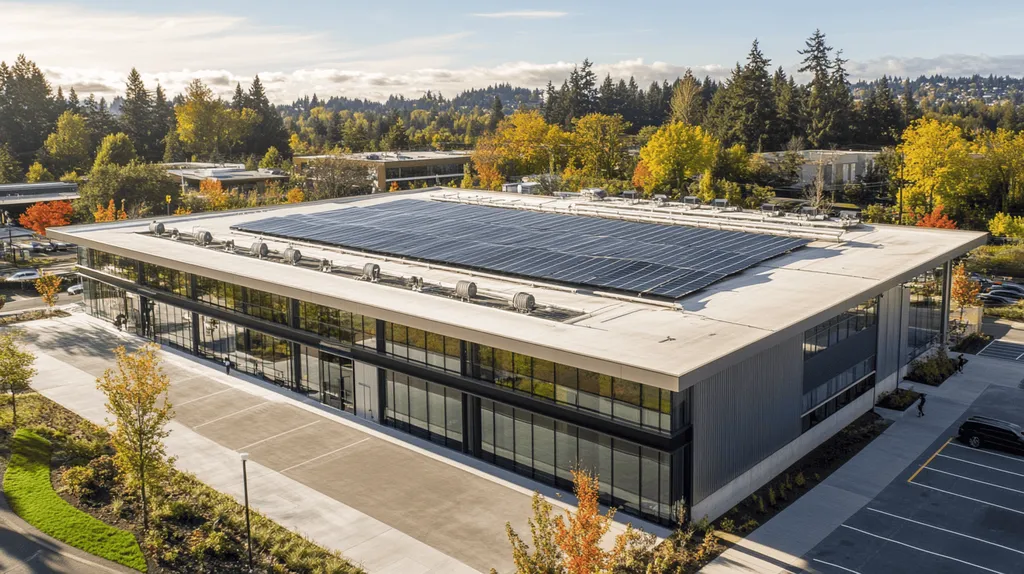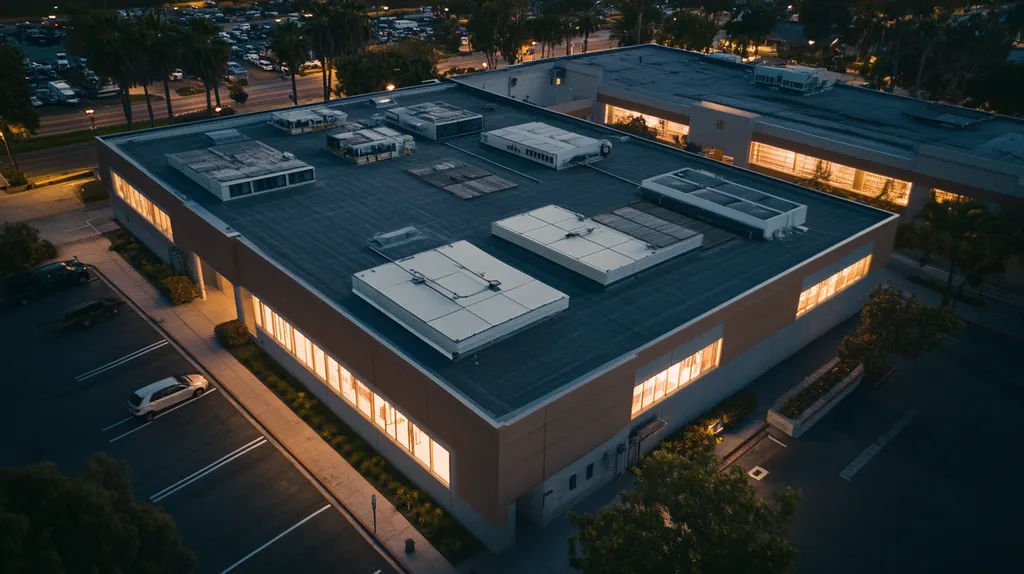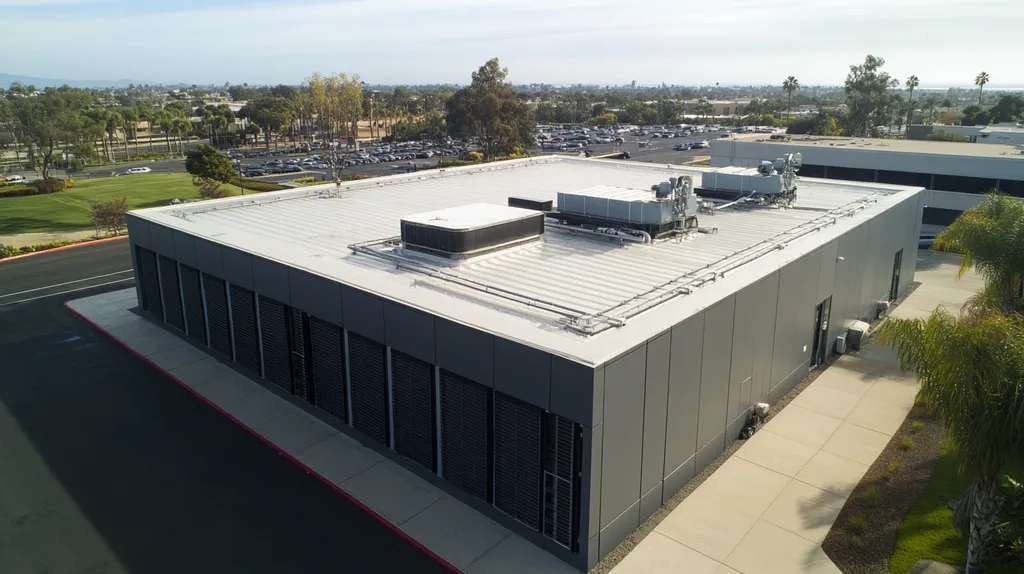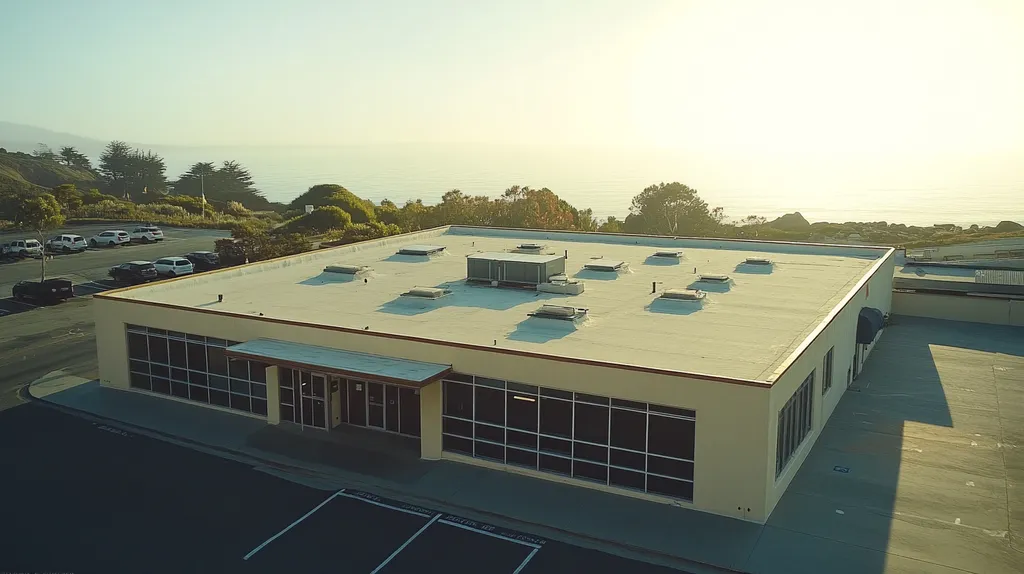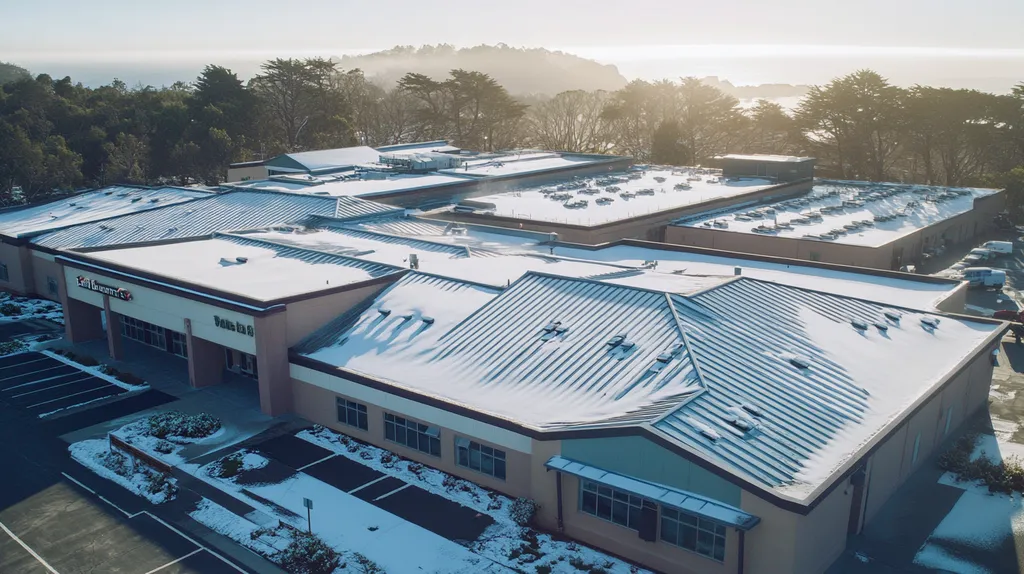Every year, neglected commercial roofs cost businesses over $2 billion in repair expenses and operational disruptions. With 40% of all building-related problems stemming from water infiltration, knowing when to repair your roof isn’t just maintenance—it’s asset protection.
From subtle warning signs to major structural concerns, understanding your roof’s repair needs can mean the difference between a minor fix and a catastrophic failure.
This guide cuts through industry jargon to deliver straightforward answers about when, why, and how to address commercial roofing repairs, helping property owners make informed decisions that protect their investments.
SECTION 1: THE BASICS EXPLAINED
Commercial roofing isn’t just a protective layer; it’s the shield that defends your property’s safety and value. Ignoring routine maintenance isn’t just a minor oversight—it can snowball into severe damage, costing property owners thousands when it inevitably fails. Recognizing when repairs are essential is crucial to keeping your building safe, operational, and free from unexpected financial blowouts. This section breaks down what commercial roofing is, why maintaining it is non-negotiable, and how to spot the early signs that repairs are needed.
What It Is (In Plain Language)
A commercial roof is the top layer of a business building, engineered to keep the weather out while providing insulation and energy efficiency. Think of it as a sturdy hat—it keeps the elements at bay. Common types include flat roofs, metal roofs, and membrane roofs, each boasting different characteristics that cater to various needs.
Diving into the specifics is essential because different roof types come with their own maintenance requirements. For example, flat roofs can easily trap water, while metal roofs require close attention to seams and joints. Ignoring these nuances can accelerate deterioration.
Property owners should also be proactive. Regular assessments can help reveal signs of wear, damage, or potential leaks before they escalate. A roof that’s routinely examined is more likely to stand the test of time, protecting the structure and its occupants. Knowing the basics is the first step toward smart maintenance decisions.
Ultimately, a well-cared-for roof doesn’t just shield the building; it promotes the overall health of the entire property.
Why It Matters (To Your Building)
Maintaining a roof isn’t merely about keeping the structure intact; it’s about safeguarding the financial investment behind it. A deteriorating roof can lead to sneaky leaks, mold growth, and extensive interior damage. A small leak might seem trivial, but it can quickly morph into a disaster, endangering equipment, inventory, or valuable office space.
Moreover, a compromised roof can skyrocket energy costs. If a roof lacks proper insulation, heated or cooled air escapes, resulting in inflated utility bills. Property owners face a choice: invest in proactive maintenance or pay through the nose for repairs and escalating energy expenses.
Tenant satisfaction is another critical angle. A well-maintained roof makes for a comfortable, safe environment, increasing tenant retention and drawing in quality renters. When property owners demonstrate a commitment to upkeep, they cultivate goodwill with tenants—a win-win.
Understanding the value of roof maintenance is essential for protecting not only the building’s integrity but also its long-term financial performance.
How It Works
To grasp how a commercial roof operates, one must recognize its layers and components. These elements work harmoniously to provide durability, insulation, and waterproofing. The top layer acts as the frontline defense against the elements, while the layers below enhance insulation and manage drainage.
Regular inspections are crucial and should include a meticulous evaluation of all these components. Qualified roofing professionals can discern early signs of wear and damage that may elude untrained eyes. Inspections often focus on critical areas like seams, flashing, and membrane integrity.
It’s also vital to consider environmental factors. Heavy rain or accumulated snow can place undue stress on a roof, making it susceptible to leaks or even collapse. Proactive assessments become essential in mitigating these risks.
By comprehending how roofs function and deteriorate over time, property owners can strategize effective maintenance and repair schedules. This approach not only protects the building but also stretches the roof’s lifespan, ensuring a better return on investment.
SECTION 2: PRACTICAL APPLICATIONS
Knowing when a commercial roof requires repairs is essential for protecting your investment. Roof damage can wreak havoc, leading to harmful leaks, structural problems, and costly interruptions in business operations. With the National Roofing Contractors Association estimating that poorly maintained roofs can dramatically shorten their lifespan by up to 30%, understanding common roofing scenarios and critical repair times becomes imperative. This section dives into the practical applications of roof maintenance, highlighting real-world examples, key moments for attention, and the interactions a roof has with other systems in your building.
Common Uses & Examples
A commercial roof isn’t just a roof—it’s a multifunctional shield against the elements while also contributing to energy efficiency. Different roofing types, like TPO or modified bitumen, come with specific maintenance challenges. Take TPO roofs, for example. They’re favored for energy efficiency, but if the seams are neglected, they can fail, leading to major headaches.
Flat roofs are another common sight in commercial structures. If the drainage systems aren’t up to scratch, they can collect water like a bathtub. Over time, this standing water can seriously degrade the roofing materials and lead to leaks that inflate repair bills.
Routine maintenance is your best defense here. Simple tasks like cleaning gutters and removing debris can make a world of difference. Biannual inspections focusing on visible wear, such as blistering or cracking, are also crucial.
Grasping these common uses and their care requirements empowers property owners to maximize both the lifespan and performance of their roofs.
When You Need It Most
There are critical moments when a roof is at heightened risk of damage, emphasizing the importance of regular inspections. For instance, after severe weather events like heavy rain or powerful winds, get up there and assess the condition. These elements can shift shingles out of place or cause water pooling, which can escalate issues if not addressed swiftly.
Seasonal transitions are prime opportunities for inspections as well. As winter approaches, for example, any cracks may deepen due to freeze-thaw cycles. Awareness of these seasonal challenges helps in addressing potential problems before they morph into costly repairs.
Don’t overlook signs inside the building either. Look out for stains or sagging ceilings—they could be a cry for help from your roof. Immediate attention to these indicators can prevent extensive damage down the line.
By pinpointing these vital moments, property owners can actively safeguard their assets and steer clear of big repair bills.
Interactions With Other Systems
Your commercial roof isn’t just sitting there—it’s part of a complex ecosystem. Take your HVAC system, for instance. A well-maintained roof is crucial for efficient ventilation. If a leak develops, moisture can seep in, sabotaging HVAC performance and compromising indoor air quality.
Moreover, your roof’s drainage system needs to work hand-in-hand with the building’s plumbing. Clogged drains can not only damage the roof but also unleash plumbing disasters that disrupt daily operations. Keeping both systems well-maintained ensures seamless functionality.
Insulation tucked beneath the roof membrane is also essential for energy efficiency. If moisture infiltrates this insulation due to roofing issues, energy costs can skyrocket. Higher air exchange rates from deficiencies can wreck your building’s climate control.
Recognizing these interactions is key for property owners, as neglect can lead to extensive, costly failures across multiple systems.
SECTION 3: KEY TERMINOLOGY DECODED
Knowing your roofing terms isn’t just beneficial; it’s essential for avoiding costly blunders. Picture this: a single miscommunication about “flashing” leads to leaks that put the integrity of your entire building at risk. This section demystifies key roofing terminology, translates the convoluted jargon of the industry, and breaks down crucial measurements. With this knowledge, property owners and facility managers can navigate roofing discussions with confidence and clarity.
Essential Terms Explained
Roofing terminology might sound like a foreign language, but it’s packed with vital implications. Take “EPDM,” for example—this durable rubber roofing is a go-to for those looking for longevity and weather resistance. Then there’s “drainage,” a critical term that describes how water is expelled from the roof to prevent pooling and leaks. Understanding “roof pitch” is just as significant; it dictates slope, which impacts drainage efficiency and structural sturdiness.
A well-informed facility manager who knows what “flashing” is can ensure it’s properly installed, warding off leaks at vulnerable seams. Similarly, recognizing what “membrane” means can open conversations about energy efficiency and material longevity. By mastering these terms, property owners can better evaluate their roofing needs and make more strategic maintenance decisions.
It’s also beneficial to familiarize oneself with concepts like “warranty” and “lifetime roofing.” A solid warranty offers financial security, while understanding how long materials are expected to last can guide thoughtful long-term planning. In roofing, clarity in terms can elevate communication with contractors to a professional level.
Industry Jargon Translated
Jargon is the wool that often blinds the eyes of non-experts in the roofing world. When contractors throw around terms like “TPO” (Thermoplastic Olefin) or “PVC” (Polyvinyl Chloride), it can leave property managers scratching their heads. TPO is known for its energy efficiency and is a popular single-ply membrane, while PVC is robust and weather-resistant—perfect for harsh environments.
The term “standing seam” is another essential phrase referring to a specific type of metal roofing known for its distinctive raised seams that interlock, creating a barrier against water. Without understanding these definitions, property owners may struggle to convey specific needs or assess the suitability of a roofing system.
Additionally, when encountering contract proposals filled with complicated jargon, it can lead to misunderstandings. A clear grasp of terms like “tear-off,” which means removing obsolete roofing layers, can affect timelines and budget plans. Simplifying industry language is vital for streamlined project management.
Measurement & Units Simplified
Roof measurements can seem intimidating, yet they are essential for accurate planning. One key unit is the “square,” which represents an area of 100 square feet. Understanding this measurement is crucial for estimating material costs and labor. For instance, knowing how many squares a roof encompasses is the first step in budgeting for any repairs.
Another critical metric is “pitch,” typically expressed as a ratio like 4:12—indicating a rise of 4 inches for every 12 inches of run. This detail is vital for assessing water runoff and ensuring an adequate drainage system. A steeper pitch may also influence material choices and installation techniques.
Don’t forget the “insulation R-value,” which measures a roof’s resistance to heat flow. A higher R-value means better insulation, which is key for energy efficiency. Property owners must understand these measurements to engage effectively with contractors and ensure their roofs meet both operational needs and energy efficiency standards.
SECTION 4: DECISION FACTORS
Deciding whether to repair a commercial roof isn’t just an afterthought; it’s a high-stakes scenario for property owners. A neglected roof can unleash a torrent of problems—think costly water damage, halted business operations, and a plummet in property value. According to research, leaking roofs can cost businesses thousands in repairs and lost revenue. By understanding factors like cost, performance trade-offs, and lifespan, property owners can make informed choices that shield not just their roof, but their bottom line.
Cost Considerations
The financial aspects of roof repairs can’t be swept under the rug. Property owners should weigh immediate repair costs against potential long-term savings. For example, a minor leak repair might only set you back a few hundred bucks, but ignoring it could escalate into thousands of dollars’ worth of water damage and structural issues.
Beyond direct expenses, consider the indirect costs that come into play. A leaky roof can disrupt business operations, leading to lost sales and damaged reputations. Choosing a proactive maintenance strategy helps ward off these headaches, allowing you to budget for future protections rather than scrambling for cash during a crisis.
When it’s time to evaluate repair costs, seeking multiple quotes can provide better clarity. A qualified contractor will help with insights on pricing, materials, and methodologies, equipping owners to make smart comparisons and informed decisions.
Ultimately, balancing costs with potential risks is the cornerstone of sound roofing decisions—helping facilities stay functional, financially stable, and protected.
Performance Trade-offs
Every choice made during repairs presents potential performance trade-offs that can impact a roof’s effectiveness. From the materials selected to the techniques employed, each decision can either enhance or diminish the roof’s overall performance. Sure, opting for a bargain patch job might save money today, but that could come back to haunt you with bigger headaches tomorrow.
A well-maintained roof doesn’t just keep water out; it often contributes to energy efficiency. Investing in high-quality materials for repairs can yield long-term benefits, with energy savings from a well-sealed roof justifying that initial expenditure.
Sometimes, repairing instead of completely replacing a roof can compromise overall performance. A structure may handle minor repairs, but significant age-related damage can lead to gaps in performance, creating a cycle of problems that demands immediate attention.
Property owners must carefully weigh these performance benefits against short-term costs to protect their investment—finding the right balance between present needs and future performance.
Lifespan & Durability Factors
The lifespan and durability of roofing materials play a critical role when considering repairs. Different materials boast different lifespans, and knowing these details can guide smarter repair decisions. For instance, TPO membranes can last 15 to 20 years, while modified bitumen might offer even more longevity when properly maintained.
When evaluating a roof’s age, owners may find that a nearing-end-of-life situation calls for extensive intervention. Conversely, a newer roof might only need some patchwork instead of a full-on replacement.
Regular maintenance can substantially extend a roof’s lifespan. Addressing small problems quickly prevents issues from escalating, enhancing overall durability. Regular inspections facilitate spotting potential trouble areas before they become major disasters, helping maintain both the roof and the property’s value.
An informed approach to repairs considers lifespan and durability, empowering property owners to make strategic decisions that enhance long-term performance and reduce the risk of unexpected costs.
SECTION 5: COMMON CHALLENGES
Commercial roofs endure a plethora of challenges that can spiral out of control if neglected. With improper maintenance leading to repairs that can average a staggering $18,000 per installation, it’s imperative for property owners to stay informed. Recognizing frequent problems, understanding warning signals, and adopting preventative measures can prevent catastrophic roof failures. By tackling these challenges head-on, facility managers can make savvy choices that safeguard their assets.
Frequent Problems & Solutions
Leaking roofs, ponding water, and blistering are the top trio of common roofing issues that can wreak havoc. Leaks often spring from cracks in seams, faulty flashing, or damaged membranes. To sidestep these headaches, regular inspections are a must—catch minor issues before they morph into major catastrophes.
Ponding water deserves its spot on the list too. When drainage isn’t up to snuff, it leads to water pooling on the surface. And guess what? This not only weakens the roof structure but also welcomes mold and mildew to the party. The fix? Install effective drainage systems or consider re-sloping the roof—essential moves to fend off the fatal risk.
Then there’s blistering, which appears as frustrating bubbles in the roofing material thanks to trapped moisture. Left unchecked, it can seriously compromise the roof’s integrity. However, repairs or replacements of affected sections, coupled with a thorough check of moisture control measures, can resolve this pesky problem.
Spotting these frequent challenges early allows property owners to implement tailored solutions that avert future complications. A proactive approach won’t just save time; it will also preserve financial resources.
Warning Signs To Watch For
It’s crucial to keep an eagle eye on warning signals that could indicate worsening roofing issues. A glaring issue is the presence of visible water stains on ceilings or walls, a telltale sign of leaks. Property owners should jump on any signs of discoloration ASAP to track down the source.
Mold and mildew should also raise alarm bells. These unwelcome guests typically hint at excessive moisture or poor ventilation, jeopardizing the roof’s longevity. Regular maintenance and ventilation checks are key to preventing these potential disasters.
Sagging or buckling roofs are serious red flags, often signaling structural issues beneath the surface. These physical deformities call for an immediate consult with a roofing professional to assess the damage and recommend necessary repairs.
Incorporating routine inspections into facility management ensures these warning signs are caught early. Taking timely action can safeguard the roof’s life and integrity.
Preventative Approaches
For commercial roofs, implementing a strong preventative maintenance program is not just recommended; it’s essential. Regular inspections, ideally twice a year, help catch potential problems before they spiral out of control. These check-ups can identify wear and tear early, allowing for proactive repairs that extend the roof’s lifespan.
Cleaning debris—leaves, dirt, and anything else perched uninvited on the roof—shouldn’t be an afterthought. Debris can trap moisture, leading to mold or deterioration of roofing materials. Scheduling seasonal cleanings keeps the roof in tip-top shape.
Drainage systems also need regular attention. Ensuring downspouts and gutters are clear can greatly minimize the risk of ponding water, a known architect of disaster. Consistent inspections of these systems ultimately foster proper water flow.
Lastly, maintaining a detailed log of all maintenance activity aids in accountability and paves the way for smarter future planning. This preventative approach not only protects the roof but pays dividends in the overall value of the property.
SECTION 6: NEXT STEPS & RESOURCES
When it comes to commercial roof maintenance, the stakes are high. Ignoring even minor repairs can lead to disastrous leaks, serious structural damages, and safety hazards that might leave property owners with an empty wallet. Proactive engagement is essential—property owners and facility managers must arm themselves with the right questions, adhere to industry standards, and tap into additional resources that will help them make sound decisions about their roofs. This section offers critical steps and references to help keep roofs intact and investments protected.
Questions To Ask Providers
When vetting roofing services, ask pointed questions to assess their expertise. Start by inquiring about their experience with your specific roofing type. This helps gauge if they have the right skills to effectively handle your unique situation.
Next, seek clarity on the materials and repair techniques they recommend. They should base their choices on your specific needs and the latest industry standards. A detailed, written estimate outlining labor and materials can’t be overlooked—transparency matters.
Don’t forget to ask about warranties and follow-up services. A trustworthy contractor will stand behind their work, offering guarantees on both materials and labor. Lastly, query their emergency response times; a quick response can significantly mitigate damages during weather-related incidents.
Industry Standards & Guidelines
Staying aligned with industry standards is crucial for effective roof maintenance. The National Roofing Contractors Association (NRCA) has established comprehensive guidelines for commercial roofing systems. Keeping abreast of these practices ensures property owners are informed about appropriate maintenance methods and their legal obligations.
Following recommendations from the American Society for Testing and Materials (ASTM) is also essential. This organization ensures that materials meet rigorous safety and performance standards, contributing to overall roof integrity.
Additionally, always consider local building codes as they differ by region. Regular reviews of these codes can prevent compliance issues and potential fines. This proactive mindset helps maintain both the quality of the roof and the safety of occupants.
Further Learning Simplified
Diving deeper into roofing knowledge benefits any property owner eager to make informed decisions. Various online resources, such as webinars and industry forums, are fantastic avenues for learning about the latest roofing trends and maintenance techniques.
Books and publications focused on commercial roofing provide comprehensive insights and case studies that can guide strategic maintenance planning. They serve as excellent references for smart decision-making.
Lastly, connecting with local roofing associations opens the door to networking opportunities. These connections allow property owners to share experiences, gaining practical advice tailored to their specific challenges and situations.
The Bottom Line
With over $2 billion lost annually to neglected commercial roofs, property owners can’t afford to play guessing games with repairs.
Understanding when your roof needs attention isn’t just about preventing leaks—it’s about protecting your entire investment from catastrophic failure.
The writing’s on the wall (hopefully not from water damage): regular inspections, prompt repairs, and working with qualified professionals are non-negotiable elements of responsible property management.
While fancy new roofing tech keeps promising miracles, the fundamentals haven’t changed: catch problems early, maintain consistently, and repair thoroughly.
The most expensive roof repair is always the one you could have prevented but didn’t.
FREQUENTLY ASKED QUESTIONS
Q. What is a commercial roof and why is it important?
A. A commercial roof protects your building from the elements and regulates energy efficiency. It’s essential for safeguarding your property’s integrity and financial investment. Regular maintenance prevents minor issues from escalating into costly disasters.
Q. How do I know if my commercial roof needs repairs?
A. Keep an eye out for signs like leaks, water stains, or visible wear. Schedule inspections after severe weather events to catch issues early. Being proactive can save you money by avoiding major repairs down the line.
Q. What are key terms I should know about commercial roofs?
A. Familiarize yourself with terms like “EPDM,” “flashing,” and “drainage.” Understanding these concepts is crucial for effective communication with contractors and can help ensure proper maintenance, avoiding costly mistakes down the line.
Q. What factors influence the decision to repair a commercial roof?
A. Consider repair costs, potential performance trade-offs, and the roof’s lifespan. Weigh the immediate expenses against potential long-term savings. Making informed decisions can prevent expensive surprises in the future while maintaining your building’s value.
Q. What are common challenges with industrial roofs?
A. Frequently encountered issues include leaks, ponding water, and blistering. Regular inspections and maintenance can help you identify and address these challenges early, preventing costly repairs and potential safety hazards.
Q. What questions should I ask roofing service providers?
A. Ask about their experience with your roofing type, recommended materials and techniques, and warranties offered. A transparent provider will be upfront about costs and contingency plans, ensuring you make an informed decision.
Q. How can I extend the lifespan of my commercial roof?
A. Implement regular maintenance like inspections and cleanings to spot issues early. Keep gutters clear and address minor problems promptly. This proactive approach can significantly extend your roof’s lifespan and save you money in repairs.

